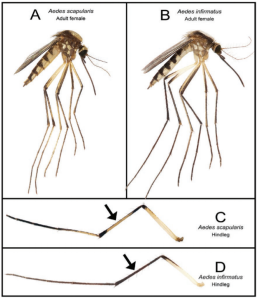The neotropical mosquito, Aedes scapularis, has a notable distribution range, spanning from Texas to areas of South America and across much of the Caribbean. The larva of this species was actually first discovered in Monroe County Florida, in the Middle Keys, in 1945. With few detections of this mosquito over the last 75 years, researchers at the University of Florida have recently shed light on its current establishment in Broward and Miami-Dade counties.

Historically, the Florida strait was thought to have acted as a geographical barrier for Aedes scapularis. As a potential result of northward areas becoming more environmentally suitable, increase in human travel, and the import and trade of ornamental and agricultural plants that may contain egg masses, this exotic pest has spread.
Studies have indicated Aedes scapularis to have a wide host range. The females primarily acquire their bloodmeal from humans, but reports have also indicated feeding on birds, rodents, reptiles, and amphibians too. It is this broad host range that may allude to this species serving as an efficient bridge vector between human and other animal pathogens. To date, up to 15 viruses have been detected in these mosquitos, including yellow fever and Venezuelan equine encephalitis virus. Still, the extent and gravity of its potential to transmit pathogens warrants further study.

To learn more about Aedes scapularis and mosquito control efforts here in Florida, check out this recent publication, CABI Aedes scapularis, and Division of Disease Control and Health Protection.
 0
0
